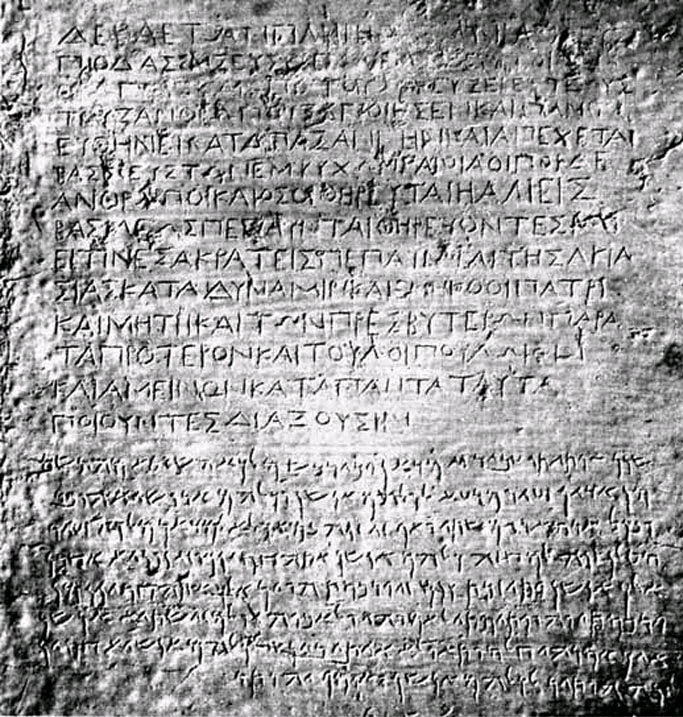|
Ayin
''Ayin'' (also ''ayn'' or ''ain''; transliterated ) is the sixteenth letter of the Semitic scripts, including Phoenician , Hebrew , Aramaic , Syriac ܥ, and Arabic (where it is sixteenth in abjadi order only). The letter represents a voiced pharyngeal fricative () or a similarly articulated consonant. In some Semitic languages and dialects, the phonetic value of the letter has changed, or the phoneme has been lost altogether (thus, in the revived Modern Hebrew it is reduced to a glottal stop or is omitted entirely in part due to European influence). The Phoenician letter is the origin of the Greek, Latin and Cyrillic letter O, O and O. It is the origin of letter Ƹ. Origins The letter name is derived from Proto-Semitic "eye", and the Phoenician letter had the shape of a circle or oval, clearly representing an eye, perhaps ultimately (via Proto-Sinaitic) derived from the ''ı͗r'' hieroglyph ( Gardiner D4). The Phoenician letter gave rise to the Greek ... [...More Info...] [...Related Items...] OR: [Wikipedia] [Google] [Baidu] |
Phoenician Alphabet
The Phoenician alphabet is an alphabet (more specifically, an abjad) known in modern times from the Canaanite and Aramaic inscriptions found across the Mediterranean region. The name comes from the Phoenician civilization. The Phoenician alphabet is also called the Early Linear script (in a Semitic context, not connected to Minoan writing systems), because it is an early development of the Proto- or Old Canaanite or Proto-Sinaitic script, into a linear, purely alphabetic script, also marking the transfer from a multi-directional writing system, where a variety of writing directions occurred, to a regulated horizontal, right-to-left script. Its immediate predecessor, the Proto-Canaanite, Old Canaanite or Proto-Sinaitic script, used in the final stages of the Late Bronze Age, first in either Egypt or Canaan and then in the Syro-Hittite kingdoms, is the oldest fully matured alphabet, and it was derived from Egyptian hieroglyphs. The Phoenician alphabet was used to write ... [...More Info...] [...Related Items...] OR: [Wikipedia] [Google] [Baidu] |
Hebrew Alphabet
The Hebrew alphabet ( he, אָלֶף־בֵּית עִבְרִי, ), known variously by scholars as the Ktav Ashuri, Jewish script, square script and block script, is an abjad script used in the writing of the Hebrew language and other Jewish languages, most notably Yiddish, Ladino, Judeo-Arabic, and Judeo-Persian. It is also used informally in Israel to write Levantine Arabic, especially among Druze. It is an offshoot of the Imperial Aramaic alphabet, which flourished during the Achaemenid Empire and which itself derives from the Phoenician alphabet. Historically, two separate abjad scripts have been used to write Hebrew. The original, old Hebrew script, known as the paleo-Hebrew alphabet, has been largely preserved in a variant form as the Samaritan alphabet. The present "Jewish script" or "square script", on the contrary, is a stylized form of the Aramaic alphabet and was technically known by Jewish sages as Ktav Ashuri, Ashurit (lit. "Assyrian script"), since its o ... [...More Info...] [...Related Items...] OR: [Wikipedia] [Google] [Baidu] |
Semitic Languages
The Semitic languages are a branch of the Afroasiatic language family. They are spoken by more than 330 million people across much of West Asia, the Horn of Africa, and latterly North Africa, Malta, West Africa, Chad, and in large immigrant and expatriate communities in North America, Europe, and Australasia. The terminology was first used in the 1780s by members of the Göttingen school of history, who derived the name from Shem, one of the three sons of Noah in the Book of Genesis. Semitic languages occur in written form from a very early historical date in West Asia, with East Semitic Akkadian and Eblaite texts (written in a script adapted from Sumerian cuneiform) appearing from the 30th century BCE and the 25th century BCE in Mesopotamia and the north eastern Levant respectively. The only earlier attested languages are Sumerian and Elamite (2800 BCE to 550 BCE), both language isolates, and Egyptian (a sister branch of the Afroasiatic family, related to the Semitic la ... [...More Info...] [...Related Items...] OR: [Wikipedia] [Google] [Baidu] |
Aramaic Alphabet
The ancient Aramaic alphabet was adapted by Arameans from the Phoenician alphabet and became a distinct script by the 8th century BC. It was used to write the Aramaic languages spoken by ancient Aramean pre-Christian tribes throughout the Fertile Crescent. It was also adopted by other peoples as their own alphabet when empires and their subjects underwent linguistic Aramaization during a language shift for governing purposes —a precursor to Arabization centuries later— including among Assyrians who permanently replaced their Akkadian language and its cuneiform script with Aramaic and its script, and among Jews (but not Samaritans), who adopted the Aramaic language as their vernacular and started using the Aramaic alphabet even for writing Hebrew, displacing the former Paleo-Hebrew alphabet. (The modern Hebrew alphabet derives from the Aramaic alphabet, in contrast to the modern Samaritan alphabet, which derives from Paleo-Hebrew). The letters in the Aramaic alphabet all ... [...More Info...] [...Related Items...] OR: [Wikipedia] [Google] [Baidu] |
Letter (alphabet)
A letter is a segmental symbol A symbol is a mark, sign, or word that indicates, signifies, or is understood as representing an idea, object, or relationship. Symbols allow people to go beyond what is known or seen by creating linkages between otherwise very different conc ... of a Phonemic orthography, phonemic writing system. The inventory of all letters forms an alphabet. Letters broadly correspond to phonemes in the spoken language, spoken form of the language, although there is rarely a consistent and exact correspondence between letters and phonemes. The word ''letter'', borrowed from Old French ''letre'', entered Middle English around 1200 AD, eventually displacing the Old English term (wikt:bookstaff, bookstaff). ''Letter'' is descended from the Latin ''wikt:littera, littera'', which may have descended from the Greek "διφθέρα" (, writing tablet), via Etruscan language, Etruscan. Definition and usage A letter is a type of grapheme, which is a functional u ... [...More Info...] [...Related Items...] OR: [Wikipedia] [Google] [Baidu] |


